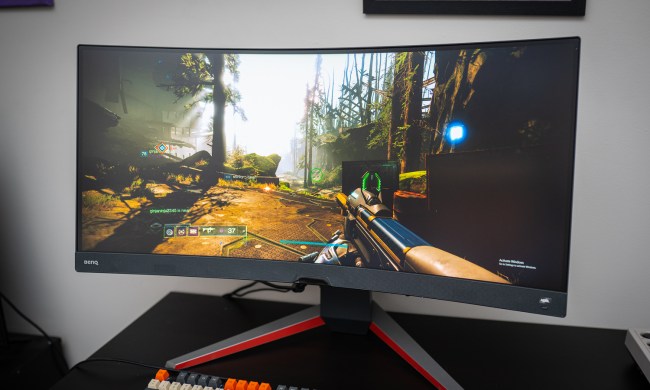
- Sturdy stand
- 4K resolution
- G-Sync compatible
- Excellent post-calibration color accuracy
- Very expensive
- Mediocre out-of-box image quality
- Limited monitor controls
No group is more likely to embrace 4K than gamers. Videophiles have to wait for a complex web of support. Formats must be updated, streaming services must be improved, and Internet bandwidth widened. Most games, though, face no such limits. 4K gaming can be enjoyed with the flip of a single in-game setting.
There’s just one obstacle – the monitor. While we’ve had 4K panels for almost two years now, gamers need more than resolution. They also demand high image quality, a dependable refresh rate, and frame synchronization support, be it through AMD’s FreeSync or Nvidia’s G-Sync.
Very few monitors can deliver all of that, but the new Asus Republic of Gamers PG27AQ is of that rare breed. Its 27-inch panel represents the cutting edge of current monitor technology. Only Acer’s XB321HK, which has similar traits in a 32-inch panel, is (theoretically) more impressive.
Of course, such features inflate the price. The PG27AQ is $900. That’s expensive, even for a 4K monitor. The excellent Dell P2715Q, for example, is $550 to $600 at most retailers. Does this Asus justify its cost, or is an over-engineered display for gamers with money to burn?
Practical meets edgy
With its thin bezels and modest profile, the PG27AQ’s panel hints at a desire to be discreet, but its lower half takes an entirely different tack. The broad base, with red glowing Republic of Gamers logo and backlit ring surrounding the stand neck, is anything but subtle. Don’t worry – it can be turned off in the monitor’s settings. Once that’s handled, you’ll have a handsome monitor that looks the business, but doesn’t jump up and scream that fact at every passerby.
The stand offers full ergonomic adjustment of height, tilt, pivot, and swivel, which puts it on par with the best office monitors. That’s great when you settle down for a long gaming session. Finding room for the massive stand base can be difficult, but its size provides a firm platform that dampens vibrations and bumps transmitted from your desk’s surface. An included VESA mount makes the monitor compatible with other stands, if for some reason the excellent one included doesn’t work out.
A pair of two-watt speakers is seamlessly built into the monitor’s enclosure. Asus’ own marketing material hardly mentions these, and for good reason. The speakers sound ok at medium volume, but distort as the volume rises. Gamers will want to rely on external speakers or a headset.
A G-Sync display with more than DisplayPort
Nvidia’s G-Sync is only compatible with DisplayPort, and in the past that’s often resulted in monitors that support DisplayPort alone. Asus’ bucks that trend with support for HDMI input, as well. There’s also earphone jack and two USB 3.0 ports, though all of these are positioned on the rear panel and face downwards, so they’re not convenient to access.
Out of control
Users access the monitor’s controls primarily through a joystick on the lower right flank of the display. It’s identical to that found on the Asus PG279Q, this monitor’s 1440p cousin, and the best joystick-style control scheme I’ve used. Tilting navigates between options, and pressing down on the stick select them. Most options can also be selected by tilting a final time towards the right.
It looks the business, but doesn’t jump up and scream that fact at every passerby.
There are many settings, including five levels of blue light filter, several monitor overdrive choices that theoretically reduce ghosting, sound options, Light In Motion (which controls the backlit logo and ring around the monitor’s base), and even adjustable monitor menu transparency.
But most of that, as you might have guessed, is of little consequence, and the monitor is lacking in image quality adjustments. Brightness, Contrast, color temperature, and a few built-in presets are all that’s available. That’s disappointing for a $900 monitor. It’s true that gamers don’t often need the fine-tuned features found in professional-grade monitors, but a gamer who spends this much on a display likely cares about how games look, and Asus should offer more control.
Pre-calibration quality
The PG27AQ comes screaming out of the box with a high maximum brightness of almost exactly 300 lux, and a non-gloss display coating. These traits create a picture that instantly grabs the viewer’s attention, even in a brightly lit room. The 4K panel, which packs 163 pixels per inch, produces sharp images when fed proper content.
Yet these traits are a double-edged sword. Colors are often blown out, and any sheer white surface is cast with a ghostly blue cast rather than a proper, pure white. This is due not only to color temperature, but overall color accuracy. Our test produced an average accuracy error of 2.08 (lower is better). That’s not bad, but it’s not great. The BenQ SW2700PT scored .84, and the Dell P2715Q scored 1.74.
Contrast is not impressive, either, at a maximum ratio of 570:1. That again is behind the Dell P2715Q, which scored 690:1, and behind the Acer XB280HK, which scored 620:1. The modest contrast level, which comes from mediocre black level performance, means the monitor can’t produce a nice, inky black.
These out-of-box issues are noticeable in movies. A 4K trailer for Suicide Squad, for example, demonstrated the lack of contrast with its many dark scenes, which often seemed missing fine detail found on other monitors. At the same time, the very blue cast given to white makes bright outdoor scenes, and even photographs, look unrealistic, as if run through a bad “HDR” filter.
The monitor’s image quality isn’t the best prior to calibration.
Games, which often embrace rather than reject exaggerated color, look better. The mediocre color accuracy is less apparent, and it’s rare to see a flat white or near-white scene. And then there’s the resolution. Content quality is a problem when streaming video to a PC, but almost every modern game can output native 4K. If you have a rig powerful enough to do it, it looks amazing, and can even give old, drab games a new life.
And games look as smooth as they do sharp, thanks to the use of G-Sync. The technology synchronizes the framerate of games with the refresh rate of the monitor to eliminate stuttering and frame tearing. We’ve taken an in-depth look at it before and found it very effective. The PG27AQ also lacks noticeable ghosting, so fast-moving objects don’t leave a trail across your screen.
Post-calibration quality
Of course, a monitor’s out-of-box performance isn’t always the best it’s capable of. For various reasons, a display often ships with settings that are not ideal. Color accuracy, in particular, is often variable – so we fired up our calibration tools to see if the PG27AQ can be made better.
Yes, it can. A lot better. After calibration we recorded an average color error of .78, which is the third best post-calibration result we’ve seen. Only the Asus PG279Q, the PG27AQ’s lower-resolution cousin, and the Samsung U32D970Q, a 32-inch 4K display designed for photography and video professionals, scored better.
The improvement is easy to notice with the naked eye. Exaggerated colors become tame, giving the monitor a window-like quality. Movies make the change most obvious. Grassy plains that were fluorescent instead look soft and inviting, while mountains that once glowed blue come closer to a pure, snowy sheen.
Contrast is still a limiting factor, however. Despite its accuracy, scenes on the monitor often lack the depth that can be found with other displays. That saps a bit of realism. Make no mistake – the contrast ratio isn’t bad. But it’s not exceptional, and it does seem to hold back a panel that is otherwise near perfection.
A solid but not exceptional warranty
A three-year warranty is included with the PG27AQ. That’s good to have, but a three year warranty is fairly common for monitors in this price range. Asus’ warranty covers any bright pixels that appear in the first year, and allows no more than five dark pixels over the same period. For the remainder of the warranty, the bright dot tolerance grows to “no more than three.”
Conclusion
Like the Asus PG279Q, the PG27AQ is a monitor that is difficult to compare with others because its feature set is so specific. Its only obvious, direct competitor is the Acer XB280HK, another 4K panel with G-Sync. The Acer holds up against the PG27AQ in most areas, but its panel is based on Twisted Nematic (TN) technology, rather than the In-Plane Switching (IPS) tech of the Asus. This difference in is the reason for the Asus’ better color accuracy.
So the PG27AQ wins, right? Not so fast. The Acer XB280HK has been around, and it’s now available for as little as $660. That’s $240 less than the PG27AQ. While Asus has superior image quality, it’s not that much better, and the Acer has a slightly higher contrast ratio. The Acer is equally sturdy, too, so there’s no advantage to be found in build quality.
If you’re looking at a 4K gaming monitor, it’s possible you’re not – shall we say – price sensitive. You need an extremely expensive PC to play games at








